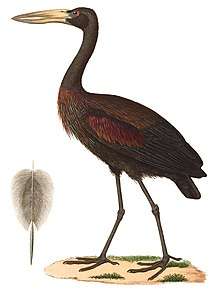Openbill stork
The openbill storks or openbills are two species of stork (family Ciconiidae) in the genus Anastomus. They are large wading birds characterized by large bills, the mandibles of which do not meet except at the tip. This feature develops only in the adults. Both species feed predominantly on molluscs. The roof of the upper bill is fringed with plate-like structures ("lamellae") in the African openbill, but these are absent in the Asian species.[1][2]
| Openbill storks | |
|---|---|
 | |
| African openbill by Huet & Prêtre | |
| Scientific classification | |
| Kingdom: | Animalia |
| Phylum: | Chordata |
| Class: | Aves |
| Order: | Ciconiiformes |
| Family: | Ciconiidae |
| Genus: | Anastomus Bonnaterre, 1791 |
| Species | |
| |
The genus Anastomus was erected by the French naturalist Pierre Bonnaterre in 1791.[3] The type species was subsequently designated as the Asian openbill (Anastomus oscitans).[4][5] The name Anastomus is from the Ancient Greek αναστομοω anastomoō meaning "to furnish with a mouth" or "with mouth wide-opened".[6]
There are two species of openbilled storks:[7]
| Image | Scientific name | Common Name | Distribution |
|---|---|---|---|
_in_Kolkata_I_IMG_0495.jpg) | A. oscitans | Asian openbill | a resident breeder in tropical southern Asia from India and Sri Lanka east to Southeast Asia. |
%2C_crop.jpg) | A. lamelligerus | African openbill | a resident breeder in Africa and Madagascar. |
References
- Beddard, F. E. (1901). "Some Notes upon the Anatomy and Systematic Position of the Ciconiine Genus Anastomus". Proceedings of the Zoological Society of London. 70: 365–371. doi:10.1111/j.1469-7998.1901.tb08551.x.
- Kahl, MP (1971). "Food and feeding behavior of Openbill Storks". Journal of Ornithology. 112 (1): 21–35. doi:10.1007/BF01644077.
- Bonnaterre, Pierre Joseph; Vieillot, Louis Pierre (1823). Tableau encyclopédique et méthodique des trois règnes de la nature: Ornithologie (in French). Part 1. Paris: Panckoucke. p. xciii. Although the title page bears the date of 1823 the section (livraison) containing the description was published in 1791. See: Dickinson, E.C.; Overstreet, L.K.; Dowsett, R.J.; Bruce, M.D. (2011). Priority! The Dating of Scientific Names in Ornithology: a Directory to the literature and its reviewers. Northampton, UK: Aves Press. p. 78. ISBN 978-0-9568611-1-5.
- Gray (1841). A List of the Genera of Birds : with their Synonyma and an Indication of the Typical Species of Each Genus (2nd ed.). London: R. and J.E. Taylor. p. 87.
- Mayr, Ernst; Cottrell, G. William, eds. (1979). Check-list of Birds of the World. Volume 1 (2nd ed.). Cambridge, Massachusetts: Museum of Comparative Zoology. pp. 246–247.
- Jobling, James A. (2010). The Helm Dictionary of Scientific Bird Names. London: Christopher Helm. p. 46. ISBN 978-1-4081-2501-4.
- Gill, Frank; Donsker, David, eds. (2019). "Storks, frigatebirds, boobies, cormorants, darters". World Bird List Version 9.2. International Ornithologists' Union. Retrieved 16 July 2019.
| Wikimedia Commons has media related to Anastomus. |